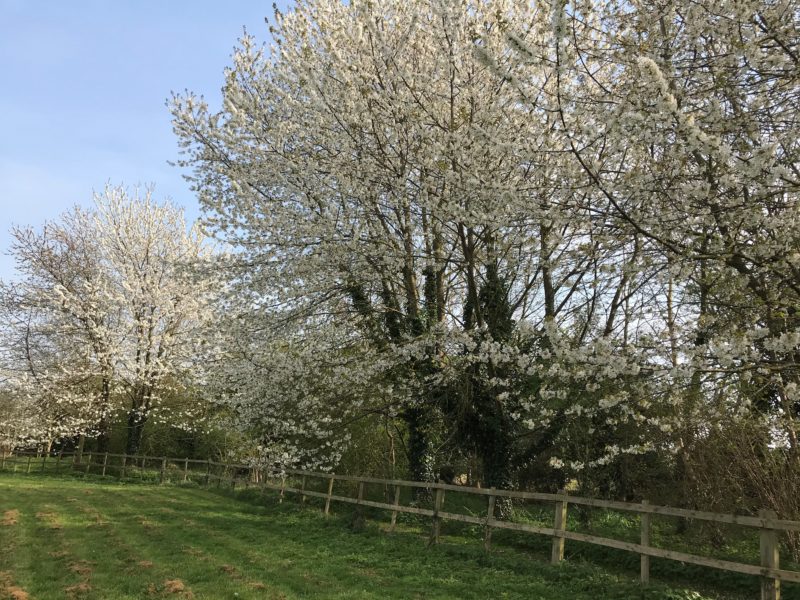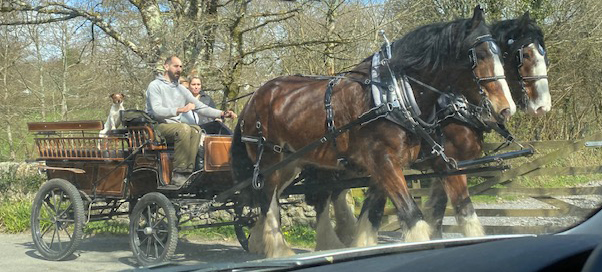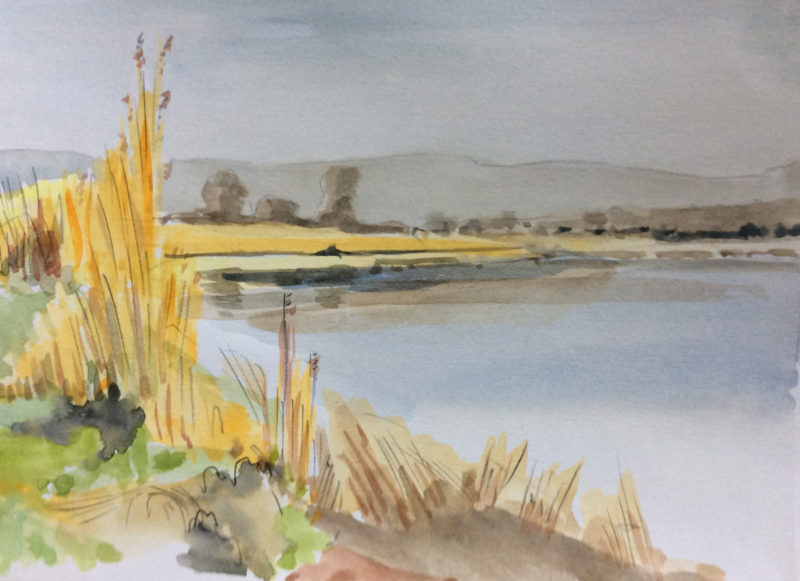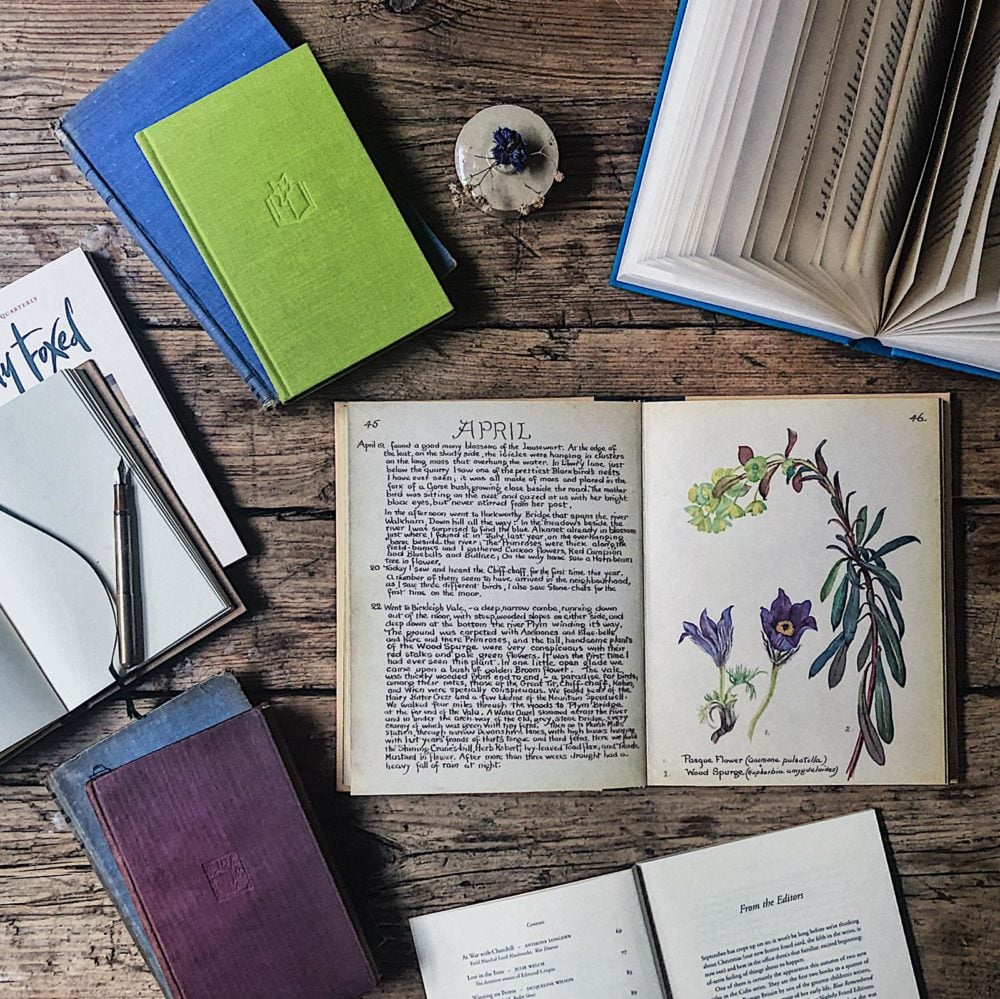Notes from Town and Country
From Hazel, Highbury, 28 April 2020
When the lockdown first began and we were instructed to leave the house only for an hour’s regular exercise we started going for an early evening walk in our local park. My husband loves Clissold Park. Over the years he’s run round it, watched birds in it, observed the trees in their various seasons, pushed our daughter on the swings, and played football with our grandchildren. He feels sentimental about it, and it is a lovely park. Like a lot of London parks it was once attached to a private house, and that has now become an upmarket café where yummy mummies sit chatting in the sun with their expensive buggies beside them, and media dads queue up for posh ice creams while speaking amusingly on the phone to other media dads.
It has beautiful trees, and an aviary, and an enclosure with goats to feed, and part of the New River, which has been supplying London with fresh water since 1613, runs through it and attracts all kinds of water birds. I wish I could love it as my husband does, but while my head tells me what a wonderful thing it is, my heart resists. I am one of those irritating people who grew up in the country and have always entertained fantasies of going back which I know will never be realized, and to me it just feels like pretend countryside, an apology for the real thing.
However, on our recent expeditions, even my husband began to find the park too much. It was hard work trying to keep the approved two metres from all the crowds of panting runners, all the toddlers on tricycles and dog owners throwing balls and zigzagging about. So instead we walked in the other direction, up to the open space known as Highbury Fields, which is not a park but just a grassy open space, divided by walks and shaded by beautiful old horse chestnuts and limes. On the lower side it is bounded by Highbury Place, begun in 1774, the year before Jane Austen was born – her Emma of course lives in a fictional village called Highbury – and on the upper by the large, handsome and slightly later Georgian houses of Highbury Terrace. Nowadays these are sold for eye-watering sums and lived in by some of the aforementioned media folk, but an old neighbour told me that during the Second World War she and her family lived in one of them, along with several other families, and that they had no electricity and no proper sanitation. Here we strolled about in heavenly peace as the sun was setting.
Now, as the lockdown continues and the situation feels more pressing, it does seem only fair that people who have gardens should leave the open spaces to people who don’t. So we do our exercises in the morning (my husband’s, a faithfully adhered-to routine taken many years ago from a second-hand Canadian Air Force fitness manual, mine somewhat half-hearted) and potter in the garden, which at this time of year is like another room, secret, green and enclosed. The pond is alive with frogs and the air is filled with birdsong – I’m told that because the London birds can now hear one another they’ve gone into overdrive this year.
A couple of Mondays ago on Radio 4 I heard a discussion between Andrew Marr and Sue Stuart-Smith, author of The Well-Gardened Mind, on – among other things – what science has discovered about the benefits of working and spending time in green places. It made me want to buy the book, and also took me back to the fascinating discussion on garden history we had with our contributor Ursula Buchan and Matt Collins of the Garden Museum in the ninth of our SF podcasts. Just before Easter Ursula sent us this uplifting picture of the wild cherries she planted on the edge of her own garden twenty-five years ago.

From Gail, Manaton, 28 April 2020
 The Devon lanes around us are now eerily quiet apart from the occasional delivery van and the odd Lycra-clad cyclist. On the smaller lanes we’ve even taken to letting the dogs off the lead ‒ such a relief as they are both terrible pullers. Our only expedition in the car is a weekly trip to one or other of our nearest towns for supplies. One route takes us down some very narrow lanes (where I always pray I won’t meet an oncoming vehicle and have to reverse all the way back to the last passing-place). Just outside a neighbouring village the road crosses the river on a very narrow double stone bridge, and this week we did meet a vehicle here – not a car but two beautifully groomed horses pulling a rather splendid cart. For once I didn’t mind in the least reversing.
The Devon lanes around us are now eerily quiet apart from the occasional delivery van and the odd Lycra-clad cyclist. On the smaller lanes we’ve even taken to letting the dogs off the lead ‒ such a relief as they are both terrible pullers. Our only expedition in the car is a weekly trip to one or other of our nearest towns for supplies. One route takes us down some very narrow lanes (where I always pray I won’t meet an oncoming vehicle and have to reverse all the way back to the last passing-place). Just outside a neighbouring village the road crosses the river on a very narrow double stone bridge, and this week we did meet a vehicle here – not a car but two beautifully groomed horses pulling a rather splendid cart. For once I didn’t mind in the least reversing.
 With each passing day the trees in the valley are coming into leaf, first the willow and the hawthorn, then larch, silver birch, beech, hornbeam, oak. They’re all beautiful in their own way but I think my favourite is the beech, and especially the single tree that stands at the end of our path and raises a pale green cloud of leaf-laden branches into the blue spring sky. As trees go it’s not especially old ‒ perhaps a century or so. To see just how magnificent trees can become I need to go my bookshelves and hunt down Thomas Packenham’s Meetings with Remarkable Trees (1996). Here’s the great beech hedge of Meikleour on Tayside, the giant Cedar of Lebanon planted at Goodwood in 1761, the vast gnarled oaks in Windsor Great Park. By the time I’ve finished browsing I’m planning future expeditions to meet some of these trees in person – first stop the arboretum at Westonbirt with its towering incense cedars. Those of you living overseas might also enjoy the sequel Packenham wrote, Remarkable Trees of the World (2002). In it you’ll meet baobabs and kauris, gum trees and sequoias, camphor trees and banyans. The best kind of armchair travelling.
With each passing day the trees in the valley are coming into leaf, first the willow and the hawthorn, then larch, silver birch, beech, hornbeam, oak. They’re all beautiful in their own way but I think my favourite is the beech, and especially the single tree that stands at the end of our path and raises a pale green cloud of leaf-laden branches into the blue spring sky. As trees go it’s not especially old ‒ perhaps a century or so. To see just how magnificent trees can become I need to go my bookshelves and hunt down Thomas Packenham’s Meetings with Remarkable Trees (1996). Here’s the great beech hedge of Meikleour on Tayside, the giant Cedar of Lebanon planted at Goodwood in 1761, the vast gnarled oaks in Windsor Great Park. By the time I’ve finished browsing I’m planning future expeditions to meet some of these trees in person – first stop the arboretum at Westonbirt with its towering incense cedars. Those of you living overseas might also enjoy the sequel Packenham wrote, Remarkable Trees of the World (2002). In it you’ll meet baobabs and kauris, gum trees and sequoias, camphor trees and banyans. The best kind of armchair travelling.
Since we moved here we’ve planted a lot of trees. First Owl Wood, which used to be a tangle of fallen conifers and brambles. Now field maples, rowans, sessile oak, birch and ash are flourishing, and beneath the canopy the primroses are spreading and the bluebells have reappeared – not yet in flower but it won’t be long. The owls are still in residence though we only ever hear them, so I don’t know what kind of owls they are.
As our planting has progressed so the shelf of books about trees has grown too. Some are devoted to individual species – maples and oaks and flowering crab apples. Others are there to help us select new trees – the RHS’s Encyclopaedia of Trees and Shrubs is invaluable. But the one I go to most often for inspiration and for the sheer pleasure of the writing is Hugh Johnson’s marvellous Trees: A lifetime’s journey through forests, woods and gardens (1973: latest edition 2010). It’s a big fat book, packed with information and photographs, and it’s become my tree bible. Next to it on the shelf sits something quite different – Jean Giono’s tiny book (only 30-odd pages) The Man Who Planted Trees, which tells the story of a French shepherd, Elzéard Bouffier, who devoted his life to planting trees and who in doing so transformed a landscape. My edition, illustrated with wood engravings by Michael McCurdy, is now out of print but I’m glad to see that a Harvill Press reissue, with an introduction by Richard Mabey, is still available.
A long conversation last week with our company accountant, Mark Robinson, about the rather dismal economic outlook. Nothing to be done about that at the moment so to cheer ourselves up we compared our local walks and I suggested he might add a diary piece. Here it is, and illustrated by him too.
From Mark, by the banks of the Severn, 28 April 2020
I’m sitting out the lockdown in my wife’s house on the right bank of the Severn, in a hamlet sandwiched between the river and the Forest of Dean, so we have bores on both sides. The wild boar in the forest, which make themselves obvious by digging up the road verges, are of a strain crossed with domestic pigs and thus, as my solicitor put it, mild boar. Encountering a sow with ten piglets in Indian file is a delight that we will probably have to forego this spring.
Last Wednesday we walked down to the riverbank to watch the Severn bore come surging upstream. It is not so much the initial tidal wave, breaking against the banks in great splashes, which impresses as the vast volume of water that follows, surging along at about ten knots and carrying huge tree trunks and every other sort of flotsam. We spotted an inflated blue surgical glove floating next to a piece of plywood in the shape of a foot, complete with all its toes. After any period of wet weather, when the river has flooded its banks, much of this stuff remains in the meadows, giving plenty of scope for inveterate beachcombers; tables and chairs, bottles, tennis balls, footballs, every conceivable plastic toy, even an ice-cream cart. I have been collecting plastic ducks – relative rarities now that duck-racing is frowned upon.
Our original plan to walk a different stretch of the river each day has had to be curtailed but last week, in a high wind, we walked the long, deserted curve around Awre (pronounced Arrgh with a good Gloucestershire burr) opposite Slimbridge. Last year’s reeds were golden in the sunlight and there were oystercatchers on the mud as well as the normal ration of duck and gulls. V-shaped flights of geese came over, all talking at once. What hell for the leading goose to have a dozen back-seat drivers – ‘left hand down a bit’, ‘we didn’t fly over this field last year’, ‘you’re too high’, ‘are we nearly there yet’?

A couple of days later we covered the stretch around Minsterworth Ham. The river is narrower here but there was no sign of Quedgeley’s urban sprawl on the far bank. We disturbed a pair of cormorants, looming like riverine vultures in a dead tree. At our approach they swept downstream, low over the water, and landed to fish half a mile further on where an old barge, pressed into the far bank, lies five foot clear of the surface, apparently held there by nothing more than the adhesive quality of river mud. There are abandoned barges on both banks; one near us is holed and slowly filling with mud each time the river floods it, home to a thicket of brambles and nesting birds. Further down on the opposite bank are the Porton Hulks, the remains of wooden sailing ships deliberately sunk there in the 1950s to stop erosion undermining the Sharpness canal which runs parallel to the river.
To round off my bore stories, some years ago, when I had just opened my first office in Cirencester, I got a telephone call from an estate agent looking for some accountants who I had never heard of. ‘Oh, you must know them,’ he said. ‘No, I am afraid not,’ I replied, ‘we accountants don’t socialize much; we find each other just as boring as everyone else does.’ An hour later two new clients walked into the office looking for ‘the accountant with a sense of humour’.






I am so enjoying these. Like Hazel I have retreated to my garden and am enjoying the bird song and the amount of wildlife available in our small South London space. It is now fox cub season which is a bit of a mixed blessing but they are a delight to watch as they gambol about destroying my plants. Gail’s piece reminded me of holidays in Devon as a child when our car scraped the walls on either side of the country lanes though we never met a horse and cart. Mark’s writing was delightful too and the very opposite of boring. Thanks so much for this glimpse of life in different parts of our enclosed country.